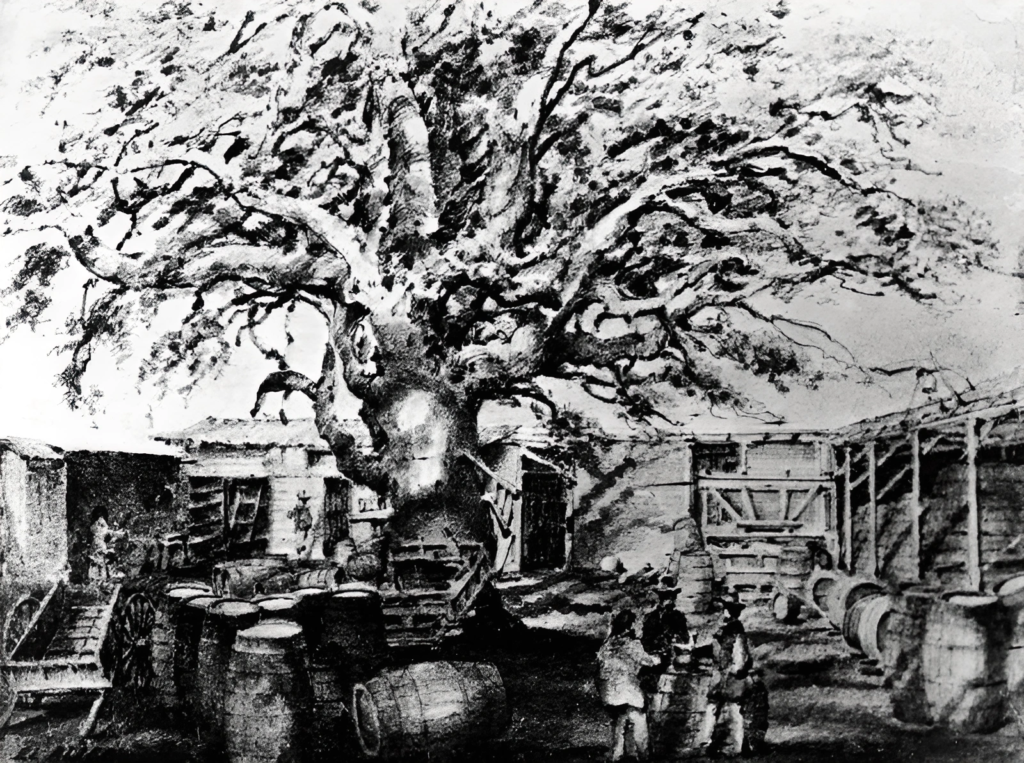At the corner of Commercial and Vignes Streets near an empty lot just south of the 101 freeway, there’s a modest plaque that commemorates one of the first landmarks of Southern California. Near this spot stood a grand sycamore tree—measuring over 60 feet tall with a canopy 200 feet wide—that witnessed 400 years of California History.
The land on which the sycamore stood was the site of Yangna (Yang-na), the largest village of the original inhabitants of this land, the Kizh (Keech) , who are also referred to as Tongva, Gabrieleno or Gabrielino. This sycamore served as a site of worship and gathering, leaders from as far as Yuma Arizona would travel to this landmark and sacred site to meet under its canopy.
The arrival of Spanish colonizers forever changed the peaceful existence of the Kizh and the landscape of the land. In 1781 the Spanish founded El Pueblo de La Reina de Los Angeles on the site of Yangna and the native people were stripped of the land and forced into a brutal existence in the California Mission era, and the sycamore tree was given the Spanish name of “El Aliso.”
El Aliso witnessed as the land went from Spanish to Mexican rule in the early half of the 1800s and survived one of the worst floods ever recorded in Los Angeles in 1825.
In 1837 the land surrounding El Aliso was sold to French immigrant Jean-Louis Vignes (Veen or “Vig-nes” as most Angelenos say it) who established a winery he named in honor of El Aliso, which shaded his wine cellar. He became so synonymous with the tree that he became known as Don Luis del Aliso. At its peak, the winery was producing almost 150,000 bottles of French-style wines a year.

Photo Credit: Wikimedia Commons
El Aliso once again saw the land change rulers from Mexican to American in 1850 and soon after, the ownership of the winery also changed when Vignes nephews Pierre and Jean Louis Sainsevain bought it in 1855 and soon produced the first sparkling wine in California.
In 1875, German immigrants bough El Aliso winery and converted it into Philadelphia Brewery, one of first established in L.A. El Aliso continued to be a feature of the landscape of the city, this time, in the courtyard of the brewery.
However, the brewery was purchased in 1882 by Joseph Maier and George Zobelein, who began to aggressively expand production, which led them to replace the brewery’s original wooden structure with brickwork buildings, which resulted in most of the branches of El Aliso being removed and the tree being enclosed on 3 sides.
Although it had survived 400 years and countless natural disasters, El Aliso could not survive the stress of urban development. In 1892, one of its larger branches fell and crushed a brewery wagon. Despite Zobelein’s best efforts, his partner Maier cut down the remaining branches and by year’s end, El Aliso was dead.
El Aliso’s trunk stood in the courtyard for 3 years, until it was unceremoniously cut and sold for firewood; any physical remnants of El Aliso were gone forever.
However, the memory of El Aliso lives on, thanks in large part to the resilience of the Kizh people, who are still here and worked to have the plaque installed. As the words inscribed on it state, “ While its physical presence is gone, the oral history handed down through the generations has kept its beauty and story alive in the Kizh people.”
So the next time you drive on the 101 near Union Station, take a moment to pay your respects to El Aliso and to the original inhabitants of the land that became Los Angeles.
References:
“El Aliso: Ancient Sycamore was Silent Witness to Four Centuries of L.A. History” by Nathan Masters, KCET. June 27, 2012.
“El Aliso | Kizh-Gabrieleño Sacred Sycamore Tree | Sha’var” Plaque, words by Chief Ernie P. Tautimez-Salas, April 2019.
“A Sycamore Deeply Rooted in City’s Past” by Cecilia Rasmussen, The L.A. Times. September 8, 2002.
“Forgotten Los Angeles History: El Aliso, the Big Tree of Los Angeles” by Kelly Wallace, L.A. Public Library Blog. April 27, 2018.

